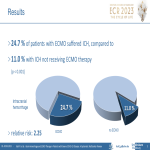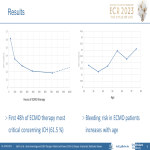Purpose
[Fig 9]
To investigate the incidence of intracranial hemorrhage in patients with severe COVID-19 disease undergoing ECMO therapy.
Methods and materials
COVID-19-associated coagulopathy in combination with therapeutic anticoagulation needed for ECMO therapy leads to an increased bleeding risk.
While minor bleeding events (e.g. at the entry sites of ECMO cannulas) can usually be easily controlled, and lager internal bleedings mostly are detected early in ICU, intracranial hemorrhage often lacks therapeutic options.
[Fig 1]
Recently published incidences for ICH in COVID-19 patients undergoing ECMO therapy vary widely from 4 % to 35 %, mostly due to
short time spans
monocentric study designs
small patient collectives
selection bias...
Results
1060 COVID-19 patients on ICU with at least one CT scan of the brain were included.
39.5 % of those received ECMO therapy at some point (468 male, 168 female; mean age 56.5 ±11 years).
[Fig 4]
While 11.0 % of patients not receiving ECMO therapy suffered an intracranial hemorrhage, a incidence of ICH of 24.7 % was found (p < 0.001), resulting in a relative risk of 2.25for suffering ICH during ECMO therapy.
[Fig 5]
High mortality rates of overall 52.2 % were found...
Conclusion
The COVID-ECMO study was able to approximate the incidence of brain haemorrhage in COVID patients receiving ECMO therapy to approximately 1 in 4 patients in German university hospitals and provide further valuable insight into the occurrence and outcome of ICH.
We look forward to further insights through the ongoing participation of additional centres.
[Fig 8]
Personal information and conflict of interest
P. J. Kuhl:
Nothing to disclose
P. Gruschwitz:
Nothing to disclose
H. Nebelung:
Nothing to disclose
C. Ehrengut:
Nothing to disclose
R. Rischen:
Nothing to disclose
Q. D. Strotzer:
Nothing to disclose
N. Kornemann:
Nothing to disclose
B. Valentin:
Nothing to disclose
T. A. Bley:
Nothing to disclose
References
Nunez, J.I., Gosling, A.F., O’Gara, B.et al.Bleeding and thrombotic events in adults supported with venovenous extracorporeal membrane oxygenation: an ELSO registry analysis.Intensive Care Med48, 213–224 (2022). https://doi.org/10.1007/s00134-021-06593-x
Pantel, T., Roedl K., Jarczak, D., Yu, Y., Frings, D.P., Sensen, B., Pinnschmidt, H., Bernhardt, A., Cheng, B., Lettow, I.et al. Association of COVID-19 with Intracranial Hemorrhage during Extracorporeal Membrane Oxygenation for Acute Respiratory Distress Syndrome: A 10-Year Retrospective Observational Study. J. Clin. Med. 2022, 11, 28. https://doi.org/10.3390/jcm11010028
Bermea, R. S., Raz, Y., Sertic, F., Rubin, J., Wolf,...











